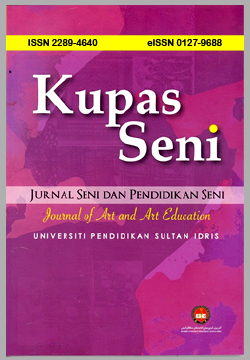The visual framing of Malaysia's National Day Press advertisement in Utusan Melayu / Malaysia from 1957 to 2007
Pembingkaian Visual Iklan Hari Kemerdekaan Malaysia Dalam Akhbar Utusan Melayu / Malaysia Tahun 1957 hingga 2007
DOI:
https://doi.org/10.37134/kupasseni.vol8.2.2.2020Keywords:
advertising, visual framing, pressAbstract
Press advertisement is one of the area of graphic communication. However, dedicated research on it has received little attention from researchers. This study discusses the use of press advertisement as a medium of communication to spread the message of National Day Celebration in Malaysia. This study, using advertisements that appear in Utusan Melayu / Malaysia in August and September commencing in 1957 until 2007. This study is a qualitative study using the method of document analysis. The visual evaluations will be applied in interview with an expert in advertising. The results show that there is a link between the visual framing of National Day advertisement with socioeconomic status, current political context, and the diversity of religious and racial communities. The implications of this study will provide a new discovery and documentation as a reference to the creative arts and design community and society.
Downloads
References
Abisheganaden, F. (1965, August 10). Singapore is out. The Straits Times, p. 1.
Ahmad Suhaimi, M. N. (2007). Sejarah Kesedaran Visual di Malaya. Tanjung Malim: Penerbitan Universiti, Universiti Pendidikan Sultan Idris.
Archer, C., & Dick, M. (2020). Pen, Print and Communication in the Eighteenth Century. Oxford: Oxford University Press.
Barres-Baker, M. (2006). An Introduction to the Early History of Newspaper Advertising. London: Brent Museum.
Beard, F. (2020). Comparative Advertising: History, Theory, and Practice. Washington DC: Lexington Books/Fortress Academic.
Druckman, J. (2001). On the Limits of Framing Effects: Who Can Frame? Journal of Politics, 63(4), 1041-1066.
D`Angelo, P., & Kuypers, J. (2010). Doing News Framing Analysis: Empirical and Theoritical Perspectives. New York: Routledge.
Entman, R. (1993). Framing: Toward Clarification of a Fractured Paradigm. Journal of Communication, 43(4), 51-58.
Gans, H. (2004). Deciding What`s News : A Study of CBS Evening News. Illinois: Northwestern University Press.
Hamedi, M. A. (2015). 100 Akhbar Melayu. Kuala Lumpur: Institut Terjemahan & Buku Malaysia Berhad.
John, C. M., & Ralph, L. L. (1979). Media messages and Men, New Perspectives in Communication. Longman.
Kamus Dwibahasa (Vol. 2). (2019). Kuala Lumpur: Dewan Bahasa dan Pustaka.
Konsulat2 Malaya, British di-pechah. (1963, Septermber 17). Berita Harian, p. 1.
McCutcheon, J., & McGaughey, F. (2020). Research Handbook on Art and Law. Cheltenham: Edward Elgar Publishing.
Merriam-Webster. (2020, November 25). Retrieved from https://www.merriamddsdsdsdwebster.com/dictionary/advertising
Miles, M. B., Huberman, M. A., & Saldana, J. (2019). Qualitative Data Analysis: An Expanded Sourcebook - Volume 14. SAGE.
Muliyadi, M. (2004). History of Malay Editorial Cartoons (1930s - 1993). Kuala lumpur: Utusan Publications & Distributors Sdn. Bhd.
Saiful Akram, C. C. (2018). Propaganda Visual Pada Era Penaklukan Jepun (1942-1945) : Manifestasi Simbolik, Retorik dan Satira Radikal. Kuala Lumpur: Institut Terjemahan & Buku Malaysia Berhad.
Semetko, H., & Valkenburg, P. (2000). Framing European Politics: A Content Analysis of Press and Television News. Journal of Communication, 50(2), 93-109.
Sheufele, B. (1999). Framing as a Theory of Media Effects. Journal of Communication, 49(1), 103-122.
Tengku Razak rayu bertenang. (1969, Mei 15). Berita Harian, p. 1.
Tuchman, G. (1978). Making News: a Study in the Construction of Reality. New York: Free Press.





